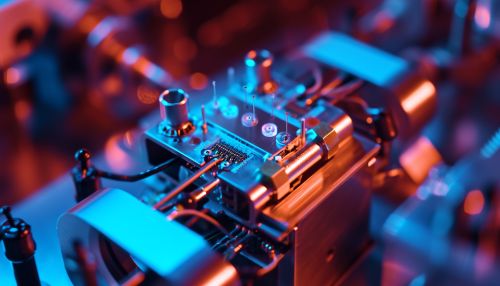Quantum Dot Lasers
Introduction
Quantum dot lasers are a type of semiconductor lasers that utilize quantum dots as the gain medium. They are known for their superior performance characteristics, including low threshold current density, high output power, and excellent temperature stability. Quantum dot lasers have found applications in various fields, including telecommunications, medical diagnostics, and scientific research.


Quantum Dots
Quantum dots are tiny semiconductor particles, typically in the range of a few nanometers in size. They are so small that they exhibit quantum mechanical properties. One of the most important properties is the quantum confinement effect, which allows the energy levels of the quantum dots to be finely tuned by simply changing their size. This property is crucial for the operation of quantum dot lasers.
Operation Principle
The operation of a quantum dot laser is based on the principle of stimulated emission. When a quantum dot is excited by an external energy source, it can emit a photon with a specific energy (or wavelength) that is determined by the size of the quantum dot. By carefully controlling the size of the quantum dots, a quantum dot laser can produce light with a very specific wavelength.
Fabrication
The fabrication of quantum dot lasers involves several complex steps. The first step is the synthesis of high-quality quantum dots with uniform size. This is usually achieved by a chemical method known as colloidal synthesis. The quantum dots are then embedded in a semiconductor matrix to form the gain medium of the laser. Finally, the laser structure is completed by adding a pair of mirrors to form an optical cavity.
Performance Characteristics
Quantum dot lasers exhibit several performance characteristics that make them superior to conventional semiconductor lasers. These include:
- Low threshold current density: Due to the three-dimensional confinement of carriers in quantum dots, quantum dot lasers can operate at much lower threshold current densities compared to conventional semiconductor lasers.
- High output power: Quantum dot lasers can produce high output power due to the high gain and high saturation output power of quantum dots.
- Excellent temperature stability: The performance of quantum dot lasers is less affected by temperature changes compared to conventional semiconductor lasers. This is because the energy levels of quantum dots are determined by their size, not by the bandgap of the semiconductor material, which is temperature dependent.
Applications
Quantum dot lasers have found applications in a wide range of fields. In telecommunications, they are used in high-speed data transmission systems due to their high output power and narrow linewidth. In medical diagnostics, they are used in fluorescence imaging and spectroscopy due to their tunable emission wavelength. In scientific research, they are used in various experiments that require precise control of light.
Future Prospects
With the continuous advancement of quantum dot technology, the performance of quantum dot lasers is expected to improve further. Potential areas of improvement include increasing the output power, reducing the threshold current density, and extending the emission wavelength range. In addition, new applications of quantum dot lasers are expected to emerge as the understanding of quantum dot physics continues to deepen.
